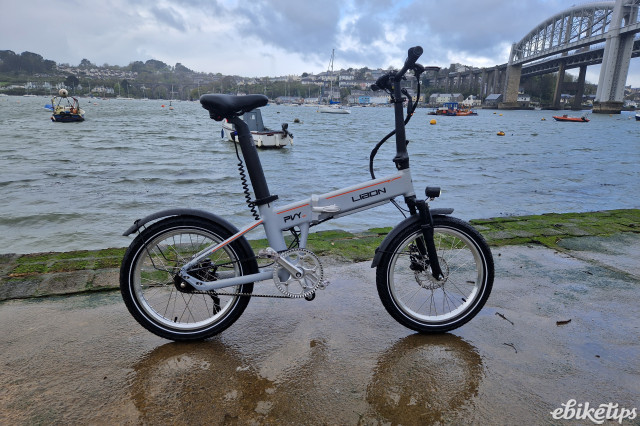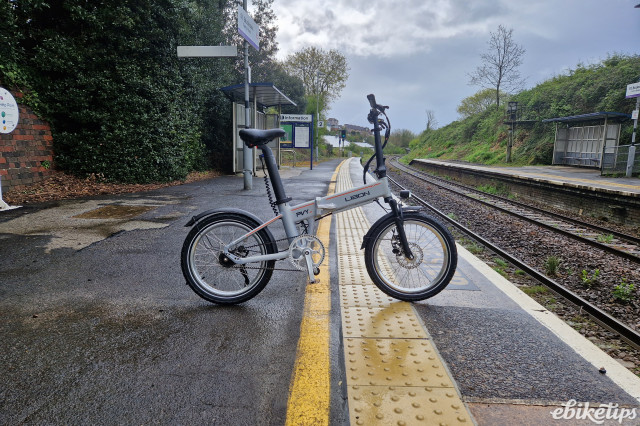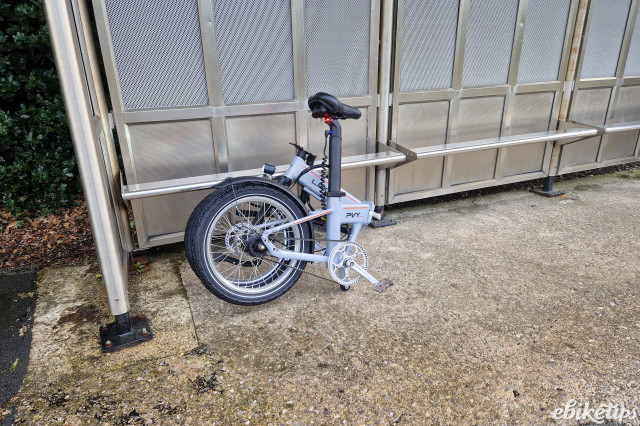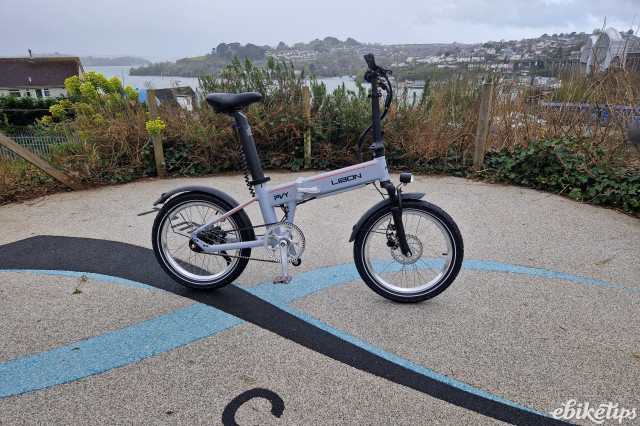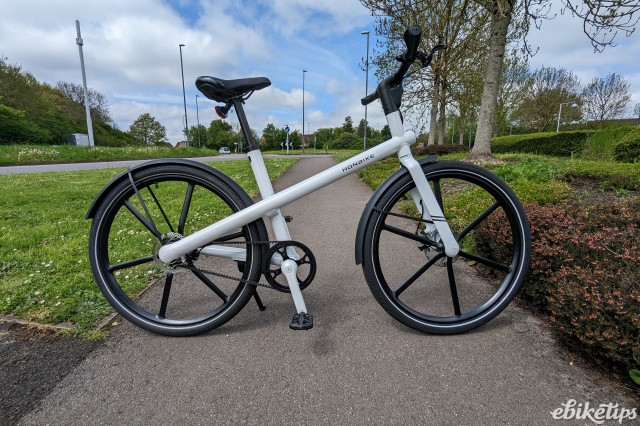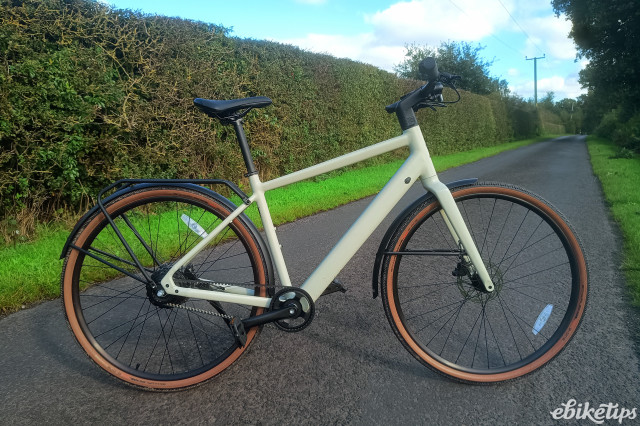The new PVY Libon is a folding e-bike with a difference. It features a dual-battery option and comes in a stylish package with a belt drive and torque sensor. I’ve been putting it through its paces to see how it compares to the competition.
The popularity of belt-driven e-bikes has risen dramatically over the last few years. With no derailleur or oily chain to worry about, they offer the ultimate in low-maintenance riding and are particularly useful for urban commuting.
PVY Libon crowdfunding page in Indiegogo
PVY is a relatively new brand that sells a range of affordable e-bikes. The Libon is their latest offering, and it is available with a single battery or as the dual battery option on test here. This bike was delivered folded up in a large box and included an accessory kit with some tools, a charger and an optional tracking tag.
Once all the packaging is removed, unfolding the bike and fitting the handlebar and pedals are all that’s required. It’s a well-finished e-bike with nice styling. The polished alloy rims and crankset add a touch of class. The general quality and feel of the bike are good — all the folding mechanisms give a reassuring click when closing, and the hinges are smooth.
Before heading out for my first ride, I charged both batteries. The main battery is inside the frame and can be charged in situ or removed. The seatpost battery can also be removed if required - as an anti-theft measure, a lock on the seatpost clamp means it cannot be removed unless you have the key.
The ride
The weather wasn’t looking great, so I decided to keep the first ride to under 20 miles. I waited for a break in the rain and headed off under gloomy skies. A few things impressed me from the outset - the 250W motor responds instantly to pedalling input and is very quiet. It’s also surprisingly punchy for a small motor, and being belt-driven, the Libon offers a smooth and quiet ride.
A handlebar-mounted colour display with Bluetooth connectivity via an app allows you to track rides, use additional security features, and manage the bike’s settings. The bike also has front and rear lights and a horn that emits an audible ‘beep’. There are three electric assist levels to choose from, although you can change this to five levels in the settings menu. I set this to five and found that levels two and three provided ample assistance. Level five was useful for a boost on steeper climbs.
As I started my ride, I forgot I was on a single-speed and reached for the gear shifter out of habit. By the time I hit the assistance limit, my legs were spinning very quickly. Trying to maintain 15mph on the flat wasn’t easy due to the low gearing, although I have been informed that the production model will get something more suitable.
I found 12mph on the test bike to be the sweet spot. In fairness, getting the gearing right on a single-speed bike is always a compromise, as it must be low enough for moderate hills but high enough for a sensible cruising speed.
Regarding performance, the power delivery is smooth, and the torque sensor reacts well to changes in pedalling force. Steeper hills require more effort, but considering my 105kg heft, it still climbs surprisingly well for a single-speed e-bike.
The steepest hill I braved was 10%, which was its limit for me, but a lighter rider may find the going easier.
The handling is best described as nimble, with no noticeable flex from the frame when riding. The big, puncture-resistant tyres add a layer of confidence that you don’t usually get with 20-inch wheels, and despite a few potholes and sunken drains, I didn’t feel the bike was compromised at any time. Indeed, the Libon handled winding descents with aplomb. The unbranded hydraulic disc brakes provided decent stopping power with good modulation.
There is a basic suspension fork up front, which works fine on the road but gets a little noisy on rougher surfaces, making an occasional knocking sound. The forks aren’t lockable, so they tend to bob up and down when you put power through the pedals. Given the bike's substantial 2.5in wide tyres, the suspension seems unnecessary. A rigid fork would have been better, and it would have saved weight.
The dual battery option is what sets the Libon apart from the competition. The single-battery version comes with a 360Wh seatpost battery. The second 374Wh battery is housed in the main beam and is accessed by unfolding the bike. Based on my testing (heavy rider, strong winds and hilly terrain), I depleted both batteries in 60 miles. On flatter terrain with better weather, a lighter rider should be able to get further, but it’s still a far cry from the claimed range of 160 miles.
Folding the PVY Libon takes seconds (with a little practice). There’s a magnetic clasp to hold the folded bike together and even a small jockey wheel on the underside of the bottom bracket. This is a nice touch and should make wheeling around a train station easier. To lower the seatpost battery, you’ll need to have the key with you. The only negative is that the sample used for this test didn’t have folding pedals.
The claimed weights of the two versions are 16kg and 18.5kg. However, this is the net weight minus the mudguards, kickstand, and pedals. The bike came up at 20kg on my scales, which is a reasonable weight considering the two batteries. If you don’t need to use the second battery, it can always be removed for easier transportation.
I’d assumed this would have a Gates Carbon Belt drive, but the belt used here is from Talengo. After doing a little research, I found they are well-known in the Asian automotive industry and appear to have a very good reputation. As for the longevity of the drive belt, I couldn’t say. Anecdotal reports for a Gates belt are around 20,000 miles.
Accessories include front and rear plastic mudguards, lights, and a kickstand. The Libon does not come with a pannier rack as standard, but one will be available as an optional extra. PVY provide a 12-month warranty on the electric components, and the frame is covered for up to 10 years.
Comfort and sizing
Regarding comfort, I had no complaints. My initial ride took me 20 miles, and the saddle and riding position were fine. With plenty of seat and handlebar height adjustment, you can dial in the comfort to suit your riding style. My 13-year-old daughter is 5ft 4in and could ride it comfortably, and I’m 6ft and had no problems. The saddle has a decent amount of padding without being too soft. The flat handlebar is a decent width, and the ergonomic grips help with hand comfort.
Alternatives
The PVY Libon will be available for £1,032 (single battery) and £1,208 (dual battery) from next month. Both models offer good value for money when compared to the alternatives.
The nearest competitor in terms of specification is the Ado Air, which costs £1,199. This also uses a torque sensor with a belt drive. The Air has a 345Wh battery and weighs 18.5 kg.
Estarli’s E20.7 Original Pro costs £1,350. It has a smaller 259Wh battery and more gears but comes from a UK manufacturer with a two-year warranty.
Finally, there’s the Eovolt Afternoon, which costs £2,199. It weighs 23.66 kg, with a 504Wh battery, and has 7-speed gearing.
Conclusion
PVY has done a good job with the Libon, and there’s not much to dislike. The motor is smooth and quiet, it’s comfortable and has an impressive battery range. I found the gearing a little too low, but this should be sorted with the final production version. I also would have preferred a rigid fork, as suspension overcomplicates things.
Apart from these minor niggles, the Libon will be a good option for commuters, particularly those who are looking to cover bigger mileages.
